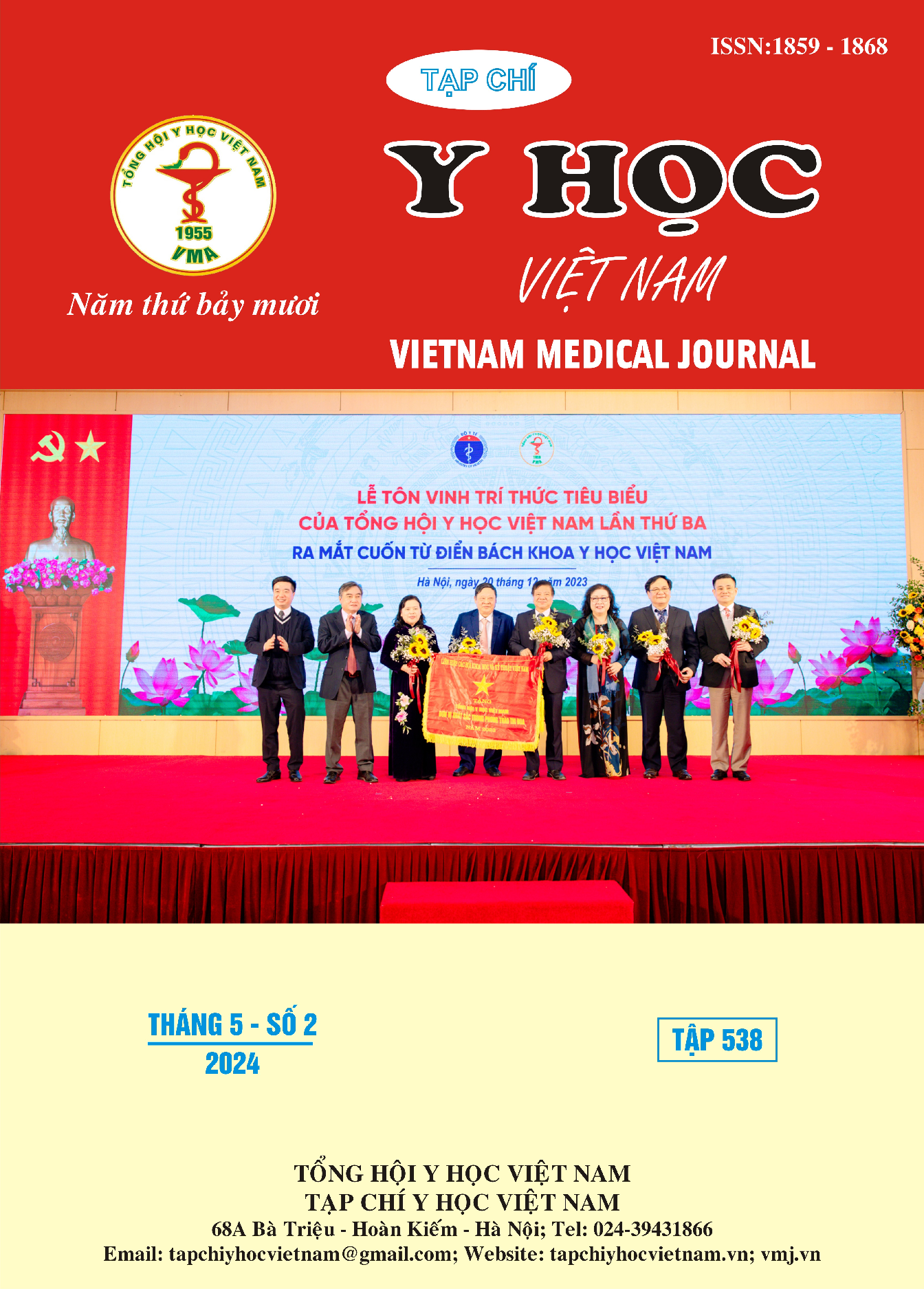THE EFFECTS OF REPEATED TRANSCRANIAL MAGNETIC STIMULATION IN THE DORSOLATERAL PREFRONTAL CORTEX VERSUS MOTOR CORTEX IN PATIENTS WITH CHRONIC NEUROPATHIC PAIN AFTER SPINAL CORD INJURY
Main Article Content
Abstract
Objective: To evaluate the effectiveness of treating neuropathic pain (NPP) after spinal cord injury (SCI) with repetitive transcranial magnetic stimulation (rTMS) in the dorsolateral prefrontal cortex (DLPFC) compared with the motor cortex main (M1). Subjects and methods: 22 patients diagnosed with NPP after SCI, received rTMS treatment according to random grouping according to the left DLPFC or M1 location (115% MT, frequency 20 Hz, total 2000 pulses in 40 minutes). cycles with each cycle duration being 2.5 seconds). Results: The average age of the study group was 52.1 ± 7.0 years; The male:female ratio is approximately 1.4:1. Regarding the level of pain reduction: VAS decreased to 4.2±0.3 at 2 weeks and 3.5±0.6 at 4 weeks of treatment for the DLPFC group. rTMS area M1 also had a VAS score of 4.3±0.5 at 2 weeks and 3.4±0.5 at 4 weeks of treatment. After 4 weeks of treatment follow-up, VAS was 3.8±0.3 and 3.6±0.4 in the DLPFC and M1 groups, respectively (p>0.05). Regarding sleep status after 2 weeks, the Pittsburgh Sleep Quality Index (PSQI) improved by 4.1±2.2 and 4.3±1.7 respectively in the above 2 groups and continued to decrease by 3.3±1.8 and 3.8±3.1 respectively at the time of treatment. point 4 weeks of treatment. After stopping rTMS stimulation for 4 weeks, these indices were still maintained in the 2 groups. For anxiety problems after SCI, Hamilton Anxiety Rating Scale (HAM-A) before treatment was 13.2±4.8 and 12.5±3.1 in the 2 groups DLPFC and M1 area, respectively. After 2 weeks of treatment, this score was 10.2±2.5 and 10.0±2.1 in each group. However, at 4 weeks of treatment, in the rTMS treatment group in the DLPFC area, the HAM-A score decreased to 6.3±1.8 and was significantly different from the treatment group in the M1 area (8.7±1.3). This difference was maintained after 4 weeks of treatment completion (p=0.022). Conclusion: rTMS stimulated in the DLPFC or M1 region can be used to improve NPP symptoms after SCI. In addition to pain relief, rTMS may also be effective in improving sleep, and rTMS in the DLPFC region may have superior effects compared to M1 in improving emotional disorders after SCI.
Article Details
Keywords
Neuropathic pain; Transcranial magnetic stimulation; Dorsolateral prefrontal cortex; Primary motor cortex.
References
2. Finnerup NB, Jensen TS. Spinal cord injury pain mechanisms and treatment. Eur J Neurol 2004;11:73–82.
3. Furlan JC, Sakakibara BM, Miller WC, et al. Global incidence and prevalence of traumatic spinal cord injury. Can J Neurol Sci 2013;40:456–64.
4. Hsu JH, Daskalakis ZJ, Blumberger DM. An update on repetitive transcranial magnetic stimulation for the treatment of co-morbid pain and depressive symptoms. Curr Pain Headache Rep 2018;22:51.
5. Jette F, Cote I, Meziane HB, et al. Effect of single-session repetitive transcranial magnetic stimulation applied over the hand versus leg motor area on pain after spinal cord injury. Neurorehabil Neural Repair 2013;27:636–43.
6. Lefaucheur J-P, Aleman A, Baeken C, et al. Evidence-Based guidelines on the therapeutic use of repetitive transcranial magnetic stimulation (rTMS): an update (2014-2018). Clin Neurophysiol 2020;131:474–528.
7. Mann R, Schaefer C, Sadosky A, et al. Burden of spinal cord injury-related neuropathic pain in the United States: retrospective chart review and cross-sectional survey. Spinal Cord 2013;51:564–70.
8. Mehta S, Orenczuk K, McIntyre A, et al. Neuropathic pain post spinal cord injury Part 1: systematic review of physical and behavioral treatment. Top Spinal Cord Inj Rehabil 2013;19:61–77.
9. Nijs J, Meeus M, Versijpt J, et al. Brain-Derived neurotrophic factor as a driving force behind neuroplasticity in neuropathic and central sensitization pain: a new therapeutic target? Expert Opin Ther Targets 2015;19:565–76.


